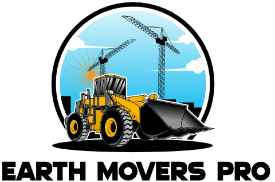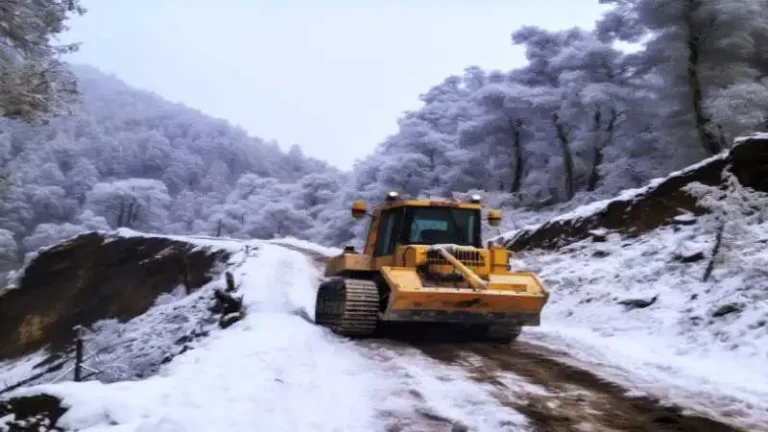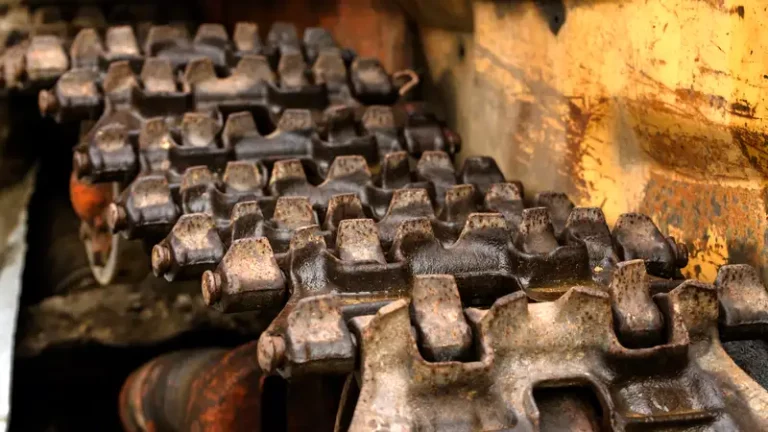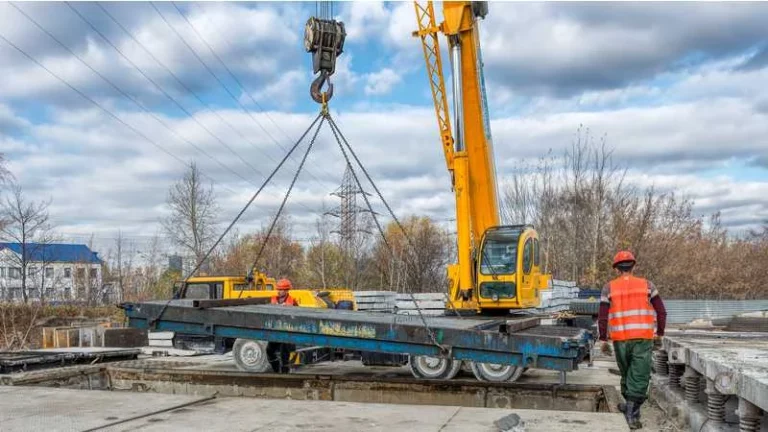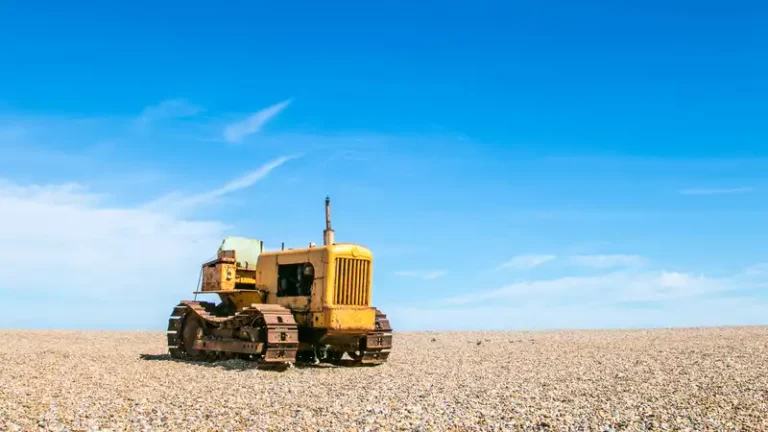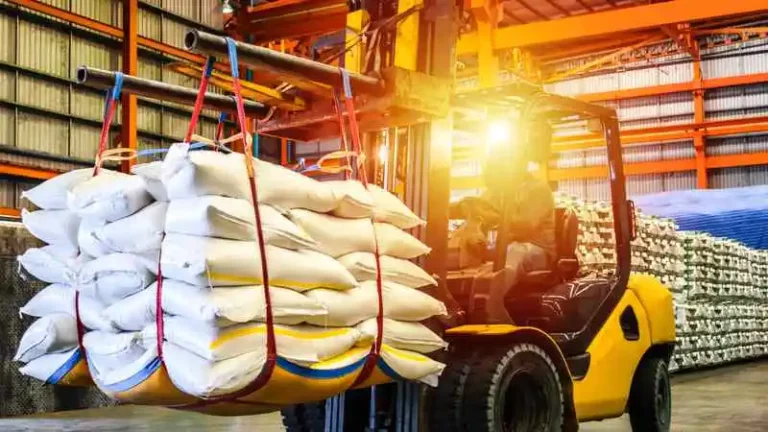Operating a bulldozer on steep slopes can be a daunting challenge. With varying factors such as soil conditions, track configurations, and operator skill affecting the machine’s climbing ability, it’s crucial to know how steep your bulldozer can safely climb.
This article will delve into the maximum slope angles for bulldozer operations, offering you key insights and actionable safety measures. Ready to power up your knowledge? Let’s dig in!
Key Takeaways
- Bulldozers can safely climb slopes with an angle of up to 35 degrees, following the 70% rule.
- Factors such as the type of machine, condition of the terrain, and operator experience influence a bulldozer’s climbing ability.
- Proper equipment positioning, assessing slope conditions, and adhering to safety guidelines are essential for safe bulldozer operation on steep slopes.
Understanding the Capabilities of a Bulldozer
Bulldozers, such as the JD crawlers discussed on the JDCrawlers messageboard, exhibit impressive capabilities in navigating various terrain conditions. These powerful machines have been designed to manage steep slopes efficiently and safely, depending on factors like soil conditions and track configuration.
John Deere crawler enthusiasts often share knowledge about different models – from a compact 350 crawler to more significant variants like the 440 crawler.
An adept operator can harness these features to climb or descend slopes at remarkable angles – even up to a whopping 45-degree angle, as seen with a BO Lindeman crawler in one instance. A key aspect here is maintaining weight balance during operation – whether your machine is blade-heavy or tail-heavy could affect its grooming capabilities for uphill tasks.
Even though traversing isn’t the main focus when climbing upward, expertise in manipulating this versatile earthmoving equipment ensures operators overcome challenging terrains while keeping safety paramount.
Factors Influencing a Bulldozer’s Climbing Ability
Several factors can influence a bulldozer’s climbing ability, including the type of machine being used, the condition of the terrain it is operating on, and the experience and comfort level of the operator.
Type of Machine
The type of machine plays a pivotal role in determining the maximum slope a bulldozer can safely climb. John Deere crawler enthusiasts often operate different models, notably the 440 and 350.
These crawlers are known for their exceptional climbing abilities, attributed to specific features such as track configuration and weight balance. For instance, a 450c crawler equipped with a winch is tail-heavy, making it ideal for backing up steep slopes without compromising stability.

Moreover, specific models, like the early JD 350 crawlers, come with footrests offering additional support when operating on challenging terrain. A user’s experience with a JD 420c further highlights how various machine types respond differently to steep gradients – despite demonstrating an impressive climbing ability on chopped hay at over 100% grade, and this model faced hydraulic oil spill issues due to its design constraints under such conditions.
Therefore, the suitable machine is essential for safe and efficient bulldozer operations on slopes.
Condition of the Terrain
The condition of the terrain plays a critical role in determining how steep a bulldozer can safely traverse a slope. Various soil conditions, such as rain-softened grounds or terrains filled with loose rocks, pose unique challenges that may affect traction and stability during the ascent or descent.
For instance, climbing wet soil could increase the risk of sliding down, while operating on loose rocks might cause an unexpected spin-out. The track configuration of your machine, too, can influence its stability – grouser bars designed for muddy conditions would behave differently on rocky terrains.
As bulldozers are often used in rugged environments, operators must assess the hill condition carefully before climbing to ensure safe operation and avoid potential engine failure due to abrupt surface composition or grade changes.
Operator’s Experience and Comfort Level
A bulldozer’s climbing ability is greatly influenced by its operator’s experience and comfort level. Operating a bulldozer on steep slopes requires skill, confidence, and an understanding of the machine’s capabilities.
Experienced operators are more adept at assessing slope conditions, adjusting their approach accordingly, and maintaining control throughout the operation. They know how to distribute the weight properly, use traction effectively, and make necessary adjustments to keep the equipment balanced on uneven terrain.
Additionally, experienced operators are better equipped to handle unexpected challenges such as loose rocks or unstable ground. Their familiarity with different soil conditions and track configurations allows them to make quick decisions that ensure both their safety and the success of the project at hand.
The Rule of Thumb for Bulldozer Climbing
The rule of thumb for bulldozer climbing is the 70%, which states that a bulldozer can safely climb slopes with an angle of up to 35 degrees. Curious to know more about how bulldozers navigate steep slopes? Keep reading!
The 70% Rule
To ensure safe bulldozer operation on steep slopes, following the 70% rule is essential. This rule states that a bulldozer should not climb a slope steeper than 70% of its maximum continued climb angle.
The maximum continued climb angle refers to the steepest incline where the bulldozer can maintain traction and stability without tipping over. Exceeding this limit significantly increases the risk of accidents and equipment damage.
So, machine operators must be aware of their specific bulldozer’s capabilities and adhere to this guideline when tackling steep terrain. By doing so, they can ensure their safety and optimize performance during bulldozer operations on challenging slopes.
Safety Measures for Operating a Bulldozer on a Steep Slope
To ensure safe bulldozer operation on steep slopes, proper equipment positioning and assessing the condition of the slope are crucial. Operators should position their machines perpendicular to the slope for maximum stability while considering factors like soil conditions, potential hazards, and environmental conditions such as rain or melting snow.
Monitoring traction and avoiding overloading the blade can help prevent spin-outs or tipping over a slope. Additionally, adhering to safety guidelines and maintaining constant awareness of the machine’s stability is essential for safe operation on steep slopes.
Equipment Positioning
Proper equipment positioning is crucial when operating a bulldozer on steep slopes. By positioning the machine correctly, you can maximize stability and minimize the risk of tipping over. It is important to ensure that the blade-heavy side of the bulldozer faces uphill, allowing for better traction and balance.
Additionally, maintaining an appropriate weight distribution by positioning attachments or extra loads toward the front of the machine helps improve stability on slopes. Continually assess the conditions and make necessary adjustments to optimize equipment positioning for safe operation on steep terrain.
Assessing the Slope Condition
Assessing the slope condition is crucial before operating a bulldozer on steep terrain. One important factor to consider is the soil conditions, as loose or slippery soil can significantly affect the machine’s traction.
Additionally, it’s essential to evaluate if there are any potential obstacles, such as rocks or fallen trees, that could impede safe operation. Rain, melting snow, ice, and mud can make slopes even more challenging to navigate.
It’s also worth noting that assessing the slope condition should be an ongoing process throughout the operation to ensure safety remains a top priority.
Consequences of Climbing Too Steep Slopes
Climbing too steep of a slope with a bulldozer can have severe consequences and pose significant risks to the operator and the equipment. One major consequence is the potential for tipping over.
When operating on a slope that exceeds the safe limit, there is an increased risk of losing traction and stability, leading to the bulldozer tipping over.
Another consequence is the potential for damage to the machine. Climbing too steep slopes can put excessive stress on various components, such as the engine, transmission, tracks, and hydraulic systems.
This can result in mechanical failures or breakdowns that require costly repairs and downtime.
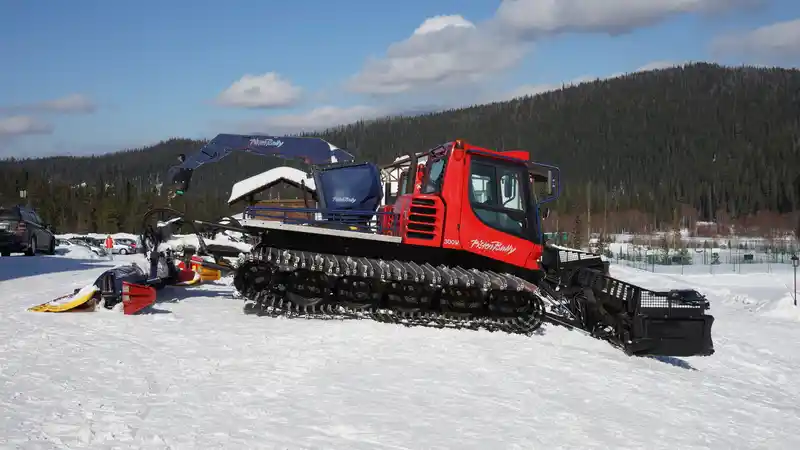
Additionally, attempting to climb excessively steep slopes may cause soil erosion or destabilize the terrain. Steep inclines often have loose rocks or soft ground conditions that cannot support heavy machinery.
This poses a risk not only to your equipment but also to nearby structures or personnel nearby.
Operators must understand their machine’s limitations and adhere to recommended safety guidelines when operating on slopes. By doing so, they can minimize these potentially dangerous consequences and ensure safe operations on challenging terrains without compromising their well-being or damaging valuable equipment.
Tips for Safe Bulldozer Operation on Slopes
Learn how to choose the right machine, follow safety guidelines, and constantly monitor and assess your surroundings for safe bulldozer operation on slopes. Read more about these essential tips here: [link to full blog post].
Choosing the Right Machine
Selecting the appropriate bulldozer for operating on steep slopes is crucial to ensure safety and efficiency. Factors such as soil conditions, track configuration, and operator skill are significant in making this decision.
For instance, a tail-heavy crawler with a winch, like the 450c model, is better equipped for backing up on steep slopes. On the other hand, loose rocks or ledges can increase the risk of spin-outs, making choosing a machine with optimal traction capabilities important.
Considering these factors will help operators make an informed choice when selecting the right machine for working on challenging terrains.
Following Safety Guidelines
To ensure the safe operation of a bulldozer on steep slopes, machine operators must follow proper safety guidelines. First and foremost, choosing the right machine for the job is essential.
Factors such as track configuration and weight balance play a significant role in ensuring stability on slopes. Additionally, operators should always wear seat belts for their protection, especially when operating on uneven terrain.
Constant monitoring and assessing the slope condition are also important to avoid potential risks or hazards. By adhering to these safety guidelines, machine operators can minimize the chances of accidents and ensure a productive and secure working environment.
Constant Monitoring and Assessment
Constant monitoring and assessment are crucial when operating a bulldozer on steep slopes. It is essential to regularly check the terrain conditions, especially if there has been rain, snow melting, or any other factors that could make the ground unstable.
Look for loose rocks, mud patches, or icy areas that could affect traction. Additionally, monitor the machine’s performance and stability as you climb or descend. Check for any signs of hydraulic oil leaks or engine failure that may compromise safety.
Remember always to prioritize your safety and be aware of your surroundings while operating the bulldozer on steep slopes.
Conclusion
In conclusion, understanding bulldozers’ capabilities and limitations when climbing steep slopes is crucial for safe operations. Factors such as soil conditions, track configuration, and operator skill significantly determine the maximum slope angles that can be safely tackled.
By following safety guidelines, constantly monitoring the terrain, and choosing the right machine for the job, operators can ensure their own safety and efficient earthmoving operations on challenging slopes.
Remember: Safety first!
